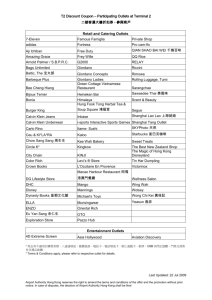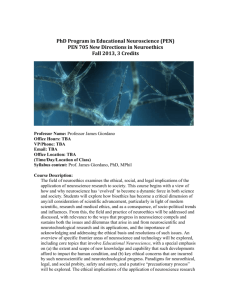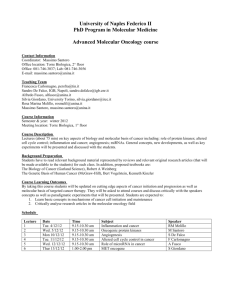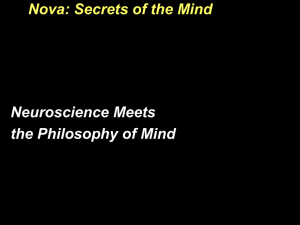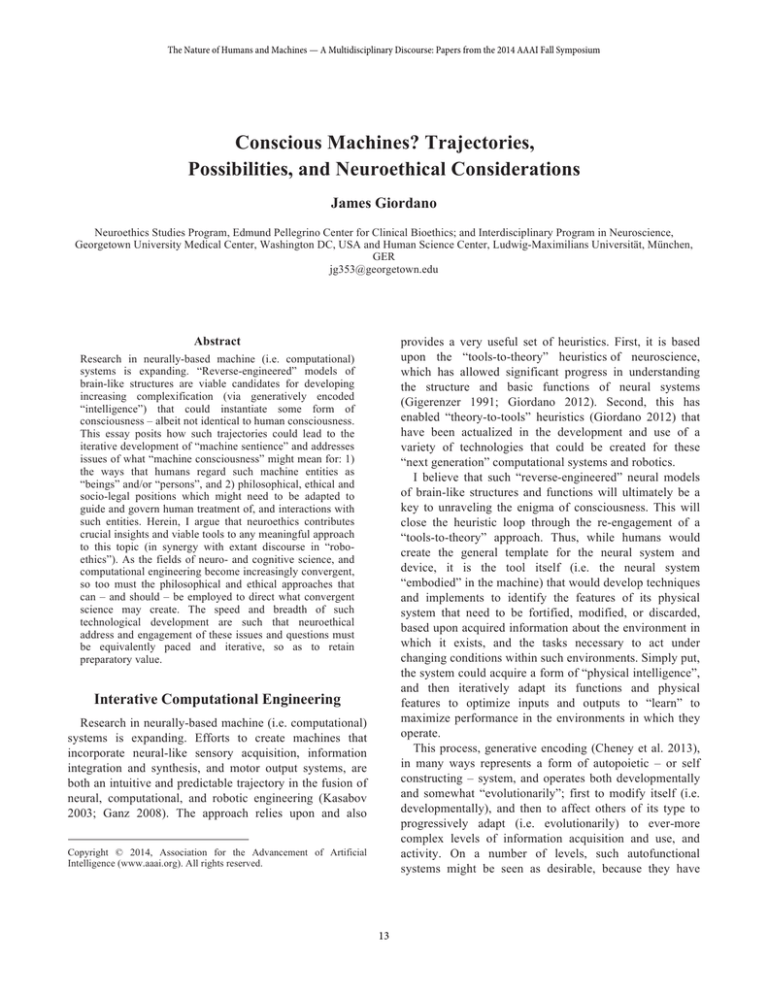
The Nature of Humans and Machines — A Multidisciplinary Discourse: Papers from the 2014 AAAI Fall Symposium
Conscious Machines? Trajectories,
Possibilities, and Neuroethical Considerations
James Giordano
Neuroethics Studies Program, Edmund Pellegrino Center for Clinical Bioethics; and Interdisciplinary Program in Neuroscience,
Georgetown University Medical Center, Washington DC, USA and Human Science Center, Ludwig-Maximilians Universität, München,
GER
jg353@georgetown.edu
Abstract
provides a very useful set of heuristics. First, it is based
upon the “tools-to-theory” heuristics of neuroscience,
which has allowed significant progress in understanding
the structure and basic functions of neural systems
(Gigerenzer 1991; Giordano 2012). Second, this has
enabled “theory-to-tools” heuristics (Giordano 2012) that
have been actualized in the development and use of a
variety of technologies that could be created for these
“next generation” computational systems and robotics.
I believe that such “reverse-engineered” neural models
of brain-like structures and functions will ultimately be a
key to unraveling the enigma of consciousness. This will
close the heuristic loop through the re-engagement of a
“tools-to-theory” approach. Thus, while humans would
create the general template for the neural system and
device, it is the tool itself (i.e. the neural system
“embodied” in the machine) that would develop techniques
and implements to identify the features of its physical
system that need to be fortified, modified, or discarded,
based upon acquired information about the environment in
which it exists, and the tasks necessary to act under
changing conditions within such environments. Simply put,
the system could acquire a form of “physical intelligence”,
and then iteratively adapt its functions and physical
features to optimize inputs and outputs to “learn” to
maximize performance in the environments in which they
operate.
This process, generative encoding (Cheney et al. 2013),
in many ways represents a form of autopoietic – or self
constructing – system, and operates both developmentally
and somewhat “evolutionarily”; first to modify itself (i.e.
developmentally), and then to affect others of its type to
progressively adapt (i.e. evolutionarily) to ever-more
complex levels of information acquisition and use, and
activity. On a number of levels, such autofunctional
systems might be seen as desirable, because they have
Research in neurally-based machine (i.e. computational)
systems is expanding. “Reverse-engineered” models of
brain-like structures are viable candidates for developing
increasing complexification (via generatively encoded
“intelligence”) that could instantiate some form of
consciousness – albeit not identical to human consciousness.
This essay posits how such trajectories could lead to the
iterative development of “machine sentience” and addresses
issues of what “machine consciousness” might mean for: 1)
the ways that humans regard such machine entities as
“beings” and/or “persons”, and 2) philosophical, ethical and
socio-legal positions which might need to be adapted to
guide and govern human treatment of, and interactions with
such entities. Herein, I argue that neuroethics contributes
crucial insights and viable tools to any meaningful approach
to this topic (in synergy with extant discourse in “roboethics”). As the fields of neuro- and cognitive science, and
computational engineering become increasingly convergent,
so too must the philosophical and ethical approaches that
can – and should – be employed to direct what convergent
science may create. The speed and breadth of such
technological development are such that neuroethical
address and engagement of these issues and questions must
be equivalently paced and iterative, so as to retain
preparatory value.
Interative Computational Engineering
Research in neurally-based machine (i.e. computational)
systems is expanding. Efforts to create machines that
incorporate neural-like sensory acquisition, information
integration and synthesis, and motor output systems, are
both an intuitive and predictable trajectory in the fusion of
neural, computational, and robotic engineering (Kasabov
2003; Ganz 2008). The approach relies upon and also
Copyright © 2014, Association for the Advancement of Artificial
Intelligence (www.aaai.org). All rights reserved.
13
“build them and leave them” qualities. Hence, humans
would assume the role of the proverbial “blind
watchmaker”: These kinds of systems would learn what
would be required to know and do to achieve a set of tasks
and goals that humans define for them – at least initially
(Fogel 2006).
But, the neural networks and vehicles (viz.
embodiments) that humans create for the system may not
necessarily be those that the system would (“choose to”)
develop for itself (i.e. think about that “special gift”
someone gave you on your last birthday – the tie with the
purple flying pigs on it, or the lime green blazer with red
stitching; often, what others think you need and want tend
to reflect their taste and wants more than your own). Recall
that what’s being proposed is the creation of real
cybernetic entities (in the strict sense of the word – a
system of progressively adaptive feed-forward/feed-back
mechanisms, as defined by Norbert Weiner), with the
complex, dynamical features that such systems obtain and
entail (Wiener 1965; Wiener and Schade 1965). These
systems are very sensitive to initial and changing
conditions, and are responsive, and adapt to various
attractors and constraints (Corning 1995) – which might
not be readily apparent to humans from outside the system.
So, the neural system could, and likely would establish its
own heuristics for what works and what doesn’t, and
employ parts-to-whole (i.e. “bottom-up”) and whole-toparts (i.e. “top-down”) self-assessments, to provide sort of
an “inside out” perspective to “teach” its builders what it
structurally requires to optimize its functions.
and ultraviolet light, and ultra and subsonic frequencies),
and 2) the informational resource of the internet. Taken
together, this would provide the system with direct-access
data/information, and indirect-access, interpretive and
analytic data/information that would greatly augment the
amount and type(s) of “knowledge” the system could and
would acquire, and be able to use.
Once these basic functions were established, the system
could interpret its “real world” environments, and parse
massive reams of data on the internet to create a
“mosaic” of the information needed to “auto-develop”
approaches to optimize its function in the environments it
encounters, and those it seeks to engage. This could then
be relayed to humans in order to create “systems’
desiderata” – a “needs’ and wish list” – to inform how to
structure and/or modify the components of the system to
achieve certain tasks, goals and even progressively more
expanding ends. The system could bring together a variety
of other system components – both of the neural network
and the physical structures that provide its inputs and
outputs – and “present” these to its human builders as
aspects of what would be needed to iteratively fine tune its
functions and capabilities. A potential advantage of this
approach would be the ability of the machine system to
side-step the limitations of human “builders’ biases”, to
instead emphasize and exploit the dispositions,
requirement, and needs of the system to self-assess and
support its own functions.
Taking this a few steps further; there is the possibility
that the system could develop and/or evolve the capacity to
“re-tool” itself, and in this way attempt to “remove the
middle man”, so to speak. The system could “propose” a
robotic component that could enable and/or sustain the
physical expression(s) of the encoding process. In other
words, it could “request” the parts needed for a “building
device” that would allow the system to execute physical
autopoiesis – more simply put, the ability to build new
parts of itself, or construct new systems (without humans
necessarily being part of the process). These new parts
could be sub-components that synergize the activities of
the major (or alpha) system, and in this way establish a
multi-tasking “support network”. This is not far-fetched;
the capacity for self-regulation is inherent to most, if not
all, cybernetic and complex dynamical systems (Corning
1995), and the achievement of certain goals would then
feed back to the system and provide an ever-expanding
palette of new niches, requirements and tasks – and
through successive self re-modeling – the generation of
new capabilities. Moreover, this could occur fairly rapidly,
as the processes employed by the system for performance
optimization might not be bounded by the restrictions of
“outside-in” (i.e. human) perspectives.
Putative Embodiment
Could these types of systems create environments and
“bodies” for themselves? To answer these questions, let’s
start a simple (and most probable) system, and then open
the discussion to include a more provocative, futuristic
vision. In so doing, let’s also establish some basic
presumptions about how a paradigm for such physically
intelligent systems/machines would be initiated and
sustained. A neurally-modeled, physically intelligent
system capable of generative encoding would need to
possess mechanisms for acquiring data, information, and
therefore some type of “knowledge” about both itself (i.e.
interoceptive knowledge), and the environments in which it
is/would be embedded and engaged (i.e. exteroceptive
knowledge). Access to “real-world” environments could
provide a medium for acquiring these data, which could be
augmented by the richness of information available on the
internet. The system could ‘plug into’ 1) the real world via
multi-channel sensors for light, sound, tactile, and perhaps
even olfactory inputs – at levels that may have very
different thresholds than humans (for example, infrared
14
small-scale inputs and outputs (e.g. at various regions of
cell membranes, and at large numbers of points of interneuronal connections within the neural network) that are
graded, and whose spatio-temporal pattern of activity
cumulatively summate to produce a “go/no-go” effect
(Giordano, Rossi, and Benedikter 2013). So, a system
modeled after or upon such neural activity could, or more
probably would, function in much the same way, and this
might provide the basis for its ongoing complexification.
Limitations
Now before we conjure dystopian visions of “intelligent
machines” taking over the world, let’s ground these
possibilities to some practical realities. Certainly, there are
a number of mitigating factors present. First is that these
systems need power, so they’d be dependent upon existing
power supplies for their resources. But, it is also possible
that such systems, if and when working in synergy, could
establish a “divert on demand” mechanism/pathway to
provide access to necessary power supplies to sustain
function across a range of environmental deprivations.
There is current discussion of the likelihood of such
mechanisms being generated by cognitive systems as some
form of “survival strategy” that almost any self-referential,
cognitive system would be likely to develop (Johnson and
Omland 2004).
Another limiting factor is that the materials for autofabrication would need to be available and acquired if such
systems were to attempt to generate physical structures to
expand their own functions. So, if humans do not provide
these substrates, then arguably, any steps toward
autopoiesis would be restrained. Perhaps, but what remains
to be seen is if and how such systems could/would learn to
fabricate or innovate their own components, so as to create
physical adaptations necessary to execute evermore
advanced/complex functions. This too is not as much of a
stretch as it sounds. A machine system that is modeled
after or upon a human neuro-cognitive template could in
fact, manifest something of a Bayesian bias toward “tool
use”, and in light of this, could learn to use the resources at
hand to alter its structure in such ways as to adapt to new
environmental challenges and “get the job done”, if not
insure its own survival (Johnson and Omland 2004).
Another possible constraint is that the digital nature of
machine computation may impose limits upon the freedom
with which expanded capability could be realized. Here I
assert that a bit of caution is warranted; a neuro-identically
modeled system (if not an idealized neurally-modeled
system) could rapidly achieve vast degrees of functional
freedom by changing the sensitivities to functional
thresholds. If the system were, for example, to develop a
broad range of discriminations between a no-response
value and response value (say, a Planck-based scale
between 0 and 1 that involves almost infinitesimally small
distinctions between each point value), it could develop
very finely-grained capacity and patterns of parsing inputs
and outputs and in this way, greatly refine – and expand –
its functional repertoire.
Neural systems actually operate in this way: while the
net effect in a given neural network may be activity or nonactivity, and that of a nerve cell may be “fire/do not fire”,
these overall characteristics reflect very finely-tuned,
Machine Consciousness, Ethical Implications
The issue that lurks right over the horizon of such
possibilities is whether increasing complexification in
generatively encoded “intelligent machines” could
instantiate some form of consciousness. I argue that the
most probable answer is “yes”; although it is likely that it
will not be identical to human consciousness. Prima facie,
this would not matter; the question is not what type of
consciousness, but whether consciousness exists. (This
opens discussion – if not a Pandora’s Box – about whether
the occurrence of consciousness in various organisms
represents a distinction of “kind” or “degree”; a full
treatment of which is beyond the scope of the present
paper). At minimum, the system would become autoreferential, and in this way, acquire a “sense of self”.
Leaving aside philosophical views of the concept of “self”,
at the most basic level this means that the system would
develop awareness of its internal state and of external
conditions and be able to discriminate between itself and
things that are not itself. This is an important step, as it
would lead to relationality – a set of functions that provide
resonance or dissonance with particular types of (internal
and/or external) environmental conditions, reinforcements
and rewards for achieving certain goals or states. In this
way the system would acquire and obtain a sense of what
neuroscientist Antonio Damasio has called “a feeling of
what happens“; in other words, a form of consciousness
(and self-consciousness) (Damasio 1999).
The question is: what then? Not only as regards the
trajectories of such machine systems, but as regards human
response and responsibility. What will we do with – and
about - this? This prompts derivative questions of if, and in
what ways we can be prepared for such new developments
(Giordano and Benedikter 2012). Granted, the likelihood
of conscious machines – as exciting as it may be – is still
years away, even given the most fruitful predictions. Any
prediction involves relative probabilities of if, how, and
what trajectories such as those described here will occur.
There is always an element of chance, and as such, there is
also the whiff of the fictional. Arguably, fictional accounts
can contribute to – and have a place in – the discourse
15
(Wurzman and Giordano 2013). Yet, while (wellconceived) fiction may be useful to illustrate social
anticipations and anxieties, I offer that rigorously-modeled
and pragmatic “what if” speculation about mindful
machines are important to 1) developing realistic scenarios
– and an appreciation for the lability of the timelines
involved in their occurrence, 2) the ‘what about’ questions
raised by the nature and implications of scientific and
technological development(s), and 3) the ways we form
and formulate philosophical beliefs, ethics, policies and
laws.
These issues – and the questions they spawn – get
particularly complicated given the capacity of neurally
modeled machines to self-assess, manifest awareness, and
self-develop and/or replicate. Yet, the very fact that there is
realistic discussion about moral consideration of and for
machines represents a shift in our epistemology and ethical
paradigm. The creation of, and discovery that an entity is
sentient is not esoteric, but instead means something both
about that organism, and the ways that it should be
considered. Neurocentric criteria, namely, whether a being
manifests the ability for pain/suffering, some form of
sentience, and the type and extent of these properties, are
arguably important for the way we morally regard – and
ethically, legally and socially treat – other beings (Loveless
and Giordano 2014a; Ryder 1970; Giordano 2014). Could
such criteria sustain a revision in the ontological status
afforded to sentient machines (or perhaps even ontological
notions generated and maintained by sentient machines
themselves)? Might such entities be considered to be
“persons”, given recent re-examination of the basis and
meaning of the term and construct (White 2007)?
What ethical approach would be best suited to address
these possibilities and the issues, questions and problems
that they may generate? Fictional accounts (e.g. - Asimov’s
Laws) of mindful machines and human-machine
engagement(s) have been offered as possible starting
points for ethical deliberation (Asimov 1964). Asimov’s
fiction is engaging, but as multiple critiques have noted,
should not be taken out of context [for overview, see
Clarke (1994)]. Instead, any ethical approach must begin
from and be based upon fact, and the discipline of ‘roboethics’ has been proposed and developed to appropriate the
realities of potentially sentient machines (Sawyer 2007;
Asaro 2006). There is merit to this; however, it may be that
a more fundamental perspective is required that enables a
deeper and broader view of the issue(s) and its
implications.
I posit that what we are really grappling with is if, and to
what extent, machines are conscious (and self-conscious),
and what that means for the ways we as humans 1) regard
them as “beings”, and 2) direct our treatment of, and
interactions with them. In this light, I argue that
neuroethics contributes crucial dimensions and insights to
any meaningful approach to this topic and its articulation
in practice (Loveless and Giordano 2014a; Giordano
2011a; Giordano 2011b; Loveless and Giordano 2014b).
Without doubt, some of the questions and problems fall
squarely into the domain of basic ethics; yet, others center
squarely upon the unique neuroscientific questions – and
answers – generated by the creation and advancement of
sentient machine entities (e.g.- about the nature and limits
of consciousness, morality, the future vision of humanity,
etc (Giordano and Benedikter 2012; Benedikter, Giordano,
and FitzGerald 2010). This begs questions of what it means
to create a sentient entity, what responsibilities arise
therefrom, and whether the presence of certain
neurocognitive capabilities and characteristics represent
not simply consciousness, or even a “person”, but life.
Ongoing neuroethical debates regarding the use of
neurological criteria to ascertain death and the status of the
human embryo reveal and reflect the contemporeity – and
gravitas – of these issues (Gazzaniga 2006). Of course,
realistic discussions of machine consciousness are still
incipient. But, the speed and breadth of technological
development are such that neuroethical address of these
issues and questions must be equivalently paced and
iterative, so as to retain preparatory value.
Science, technology, and the knowledge and artifacts
they produce are human creations; therefore, responsibility
to deal with the outcomes of our creations rests in human
hands. As the fields of neuro- and cognitive science, and
computational and bioengineering become increasingly
convergent, so too must the philosophical, ethical and
socio-legal approaches that can – and should – be
employed to guide and govern what convergent science
may create (Giordano 2012). And this harkens back to my
musings about conscious machines. It’s provocative,
arguably a useful exercise – and perhaps fun – to speculate
on what neuroscience and neurotechnology hold for the
future (Wurzman and Giordano 2013). But it’s folly not to
critically assess what this science holds for the present,
foolhardy not to recognize the promise and perils that such
science and technology may incur, and frighteningly
dangerous not to devote time, effort and resources to
studying, and developing ways to be prepared for, and
prudently guide each and every step ahead.
Acknowledgments
This work was funded in part by the J. W. Fulbright
Foundation, Clark Foundation, and William H. and Ruth
Crane Schaefer Endowment.
16
and Treatment of Human and Non-human Beings. Abstracts of
the International Neuroethics Society 6:15.
Loveless, S. E., and Giordano, J. 2014b. Neuroethics, Painience
and Neurocentric Criteria for the Moral Treatment of Animals.
Cambridge Quarterly of Healthcare Ethics 23(2): 163-172.
Ryder, R. 1970. Speciesism. London: Centaur.
Sawyer, R. J. 2007. Robot Ethics. Science 318 (5853): 1037.
White, T. 2007. In Defense of Dolphins. The New Moral Frontier.
Oxford: Wiley-Blackwell.
Wiener, N., and Schade J. P. eds. 1965. Cybernetics of the
Nervous System. NY: Elsevier.
Wiener, N. 1965. Cybernetics, or Control and Communication in
the Animal and Machine. Cambridge MA: MIT Press.
Wurzman, R., and Giordano, J. 2013. Neuroscience Fiction as
Eidolá: On Neuroethical Roles and Responsibilities in
Representations of Neuroscience. AJOB-Neuroscience 3 (Suppl):
15.
References
Asaro P. M. 2006. What Should we Want from a Robot Ethic?
International Review of Information Ethics 6: 11-12.
Asimov, I. 1964. The Rest of the Robots. NY: Doubleday.
Benedikter R.; Giordano J.; and FitzGerald, K. 2010. The Future
of the Self-image of the Human Being in the Age of
Transhumanism, Neurotechnology and global transition. Futures
Journal 42(10): 1102-1109.
Boccaletti S., et al. 2006. Complex Networks: Structure and
Dynamics. Physics Reports 425(4-5): 175-308.
Cheney N., et al. (2013) Unshackling evolution: Evolving Soft
Robots with Multiple Materials and a Powerful Generative
Encoding. Proceedungs of the Fifteenth Annual Conference on
Genetics, Evolution and Computing 167-174.
Clarke, R. (1994) Asimov's Laws of Robotics: Implications for
Information Technology. Part 2: IEEE Computer: 57–66
Corning, P. A. 1995. Synergy and Self-organization in the
Evolution of Complex Systems. Systems Research in Behavioral
Science 12(2): 89-121.
Damasio, A. 1999. The Feeling of What Happens: Body and
Emotion in the Making of Consciousness. NY: Harcourt.
Fogel, D. B. 2006. Evolutionary Computation: Toward a New
Philosophy of Machine Intelligence. NY: Wiley.
Ganz, D. 2008. Progress in Machine Consciousness.
Consciousness and Cognition 17(3): 887-910.
Gazzaniga, M. 2006. The Ethical Brain: The Science of our
Moral Dilemmas. NY: Harper.
Gigerenzer, G. 1991. From Tools to Theories: A Heuristic of
Discovery in Cognitive Psychology. Psychological Reviews
98(2): 254-267.
Giordano, J., and Benedikter, R. 2012. An Early - and Necessary
- Flight of the Owl of Minerva: Neuroscience, Neurotechnology,
Human Socio-cultural Boundaries, and the Importance of
Neuroethics. Journal of Evolution and Technology 22(1): 14-25.
Giordano, J.; Rossi P. J.; and Benedikter R. 2013. Addressing the
Quantitative and Qualitative: A View to Complementarity – From
the Synaptic to the Social. Open Journal of Philosophy 3(4): 1-5.
Giordano, J. 2011a. Neuroethics: Traditions, Tasks and Values.
Human Prospect 1(1): 2-8.
Giordano, J. 2011b. Neuroethics- Two Interacting Traditions as a
Viable Meta-ethics? AJOB-Neuroscience 3(1): 23-25.
Giordano, J. 2012. Integrative Convergence in Neuroscience:
Trajectories, Problems and the Need for a Progressive
Neurobioethics. In: Vaseashta, A.; Braman, E; and Sussman, P.
eds. Technological Innovation in Sensing and Detecting
Chemical, Biological, Radiological, Nuclear Threats and
Ecological Terrorism. (NATO Science for Peace and Security
Series), NY: Springer.
Giordano, J. 2014 The Human Prospect(s) of Neuroscience and
Neurotechnology: Domains of Influence and the Necessity – and
Questions – of Neuroethics. Human Prospect 4(1): 1-18.
Johnson, J. B., and Omland, K. S. 2004. Model Selection in
Ecology and Evolution. Trends in Ecology and Evolution 19(2):
101-108.
Loveless, S. E., and Giordano, J. 2014a. Consciousness as a Core
Neurocentric Criterion for Neuroethical Considerations,
Responsibility and Guidance of Moral, Social and Legal Regard
17


